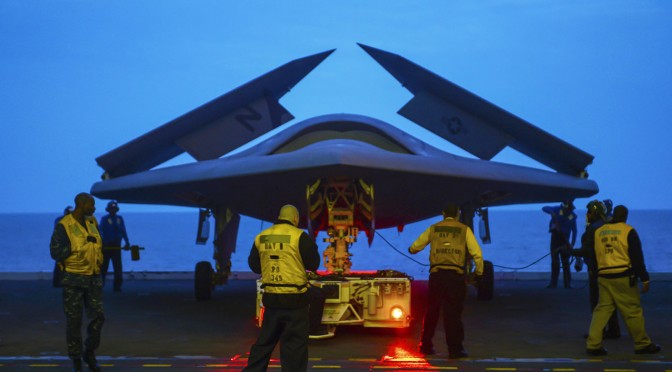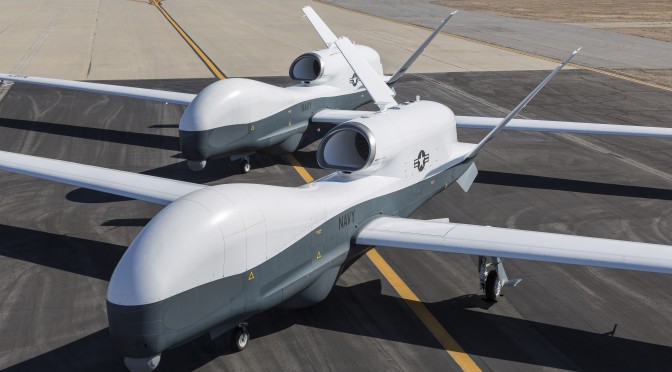By Michael Glynn
Aviators and operators hitting the fleet today have reasons to be excited. Naval Aviation is in the process of recapitalizing the fleet with a stable of very capable platforms and sensors: the E-2D carrying the highly advanced APY-9 multifunction radar; the P-8A with a powerful acoustic system and the APS-154 Advanced Airborne Sensor radar; and the EA-18G armed with the very capable ALQ-218 electronic warfare system and Next Generation Jammer.
The advances are not restricted to manned platforms alone. The MQ-4C will enable wide area search and ISR operations, covering hundreds of thousands of square miles during 30 hour flights. The MQ-8C will bring impressive endurance to small deck surface ships. Longer dwell time promises to yield more collection opportunities and push more data to warfighters.
But observers should be cautioned that these new platforms, new sensors, and emerging autonomy won’t necessarily yield higher quality intelligence or more information to commanders. Warfighters today are fighting not to generate enough information, but rather to manage the incredible amounts of data that today’s sensors record and store. The fleet is struggling to keep from being drowned in a sea of data. The battle of the information age is to separate the useful information from the vast amount of meaningless noise.
Our sensors today already develop tremendous amounts of data. How do we store it, access it, make sense of it, and disseminate it? How will we manage this in the future with even more data as unmanned systems become more common? Can autonomy and data fusion be part of the answer? Will our training and intelligence analysis need to change? Let’s examine these challenges in detail.
Large Data Sets, Autonomy, and Data Fusion
The increasing use of unmanned systems will bring longer mission profiles and hence longer windows of time where sensors can collect. This will generate extremely large amounts of information each flight. To put the challenge in perspective, consider a modern maritime patrol aircraft, the P-8A and its partner, the soon to be deployed MQ-4C UAV. On an eight hour mission, a Poseidon will generate up to 900 gigabytes of sensor information. How much more data will the unmanned Triton generate during its thirty hour flights?
Any operator in the fleet will admit that the amount of data gathered by our platforms today far surpasses the bandwidth of our long range communication networks. What happens to data that can’t be transferred off an aircraft during its mission? How best to manage information that may be over a day “time-late” when a UAV lands? What sensor information should be broadcast to operators ashore and what should be saved for post-flight access? These are challenging questions for program mangers, requirements officers, and operators to solve.
In the same vein, the large data set generated by sensors today offers the possibility of using analytics to sift through them and draw conclusions. However, this will only happen if managers design suitable architectures to extract the data post-flight, store it, and make it available to customers. We will discuss this concept later.
A second broad trend worth mentioning is automation and the ability to use technology to parse the data. Algorithms in modern sensors allow these systems to automatically capture, store, and disseminate information. Legacy surface search radars required an operator to manually plot a contact, log its position on paper, and update the position as time went by. Modern surface search radars can automatically identify, assign track numbers, and update tracks of dozens, if not hundreds of contacts, and promote certain tracks to datalinks such as Link 16. The track information is also recorded on-board and available for post-mission download, analysis, and storage.
The benefits of automation and data storage don’t end there. Today’s platforms either already do or will soon employ data fusion engines that merge complimentary information from multiple sensors to produce a higher-fidelity view of the battlespace. These systems will identify a surface contact by radar and overlay an electronic line of bearing signal that arrives from the same direction as the radar contact. The fusion engine will recognize the radar signal is coming from that ship and by analyzing the parameters of the signal might be able to provide a possible identification of the type of vessel. The system will then merge the radar contact and the electronic emission into a single track and promote it automatically to a datalink.
The capability of our sensors and our ability to store the data they produce is improving rapidly. Unless we think about how we collect and process this data, we risk not being able to capitalize on the capability. Let’s examine some actions we can take to prevent the technological advances from outpacing our ability to control them.
Recognizing the Challenge
Our warfighters and intelligence professionals need to examine the process by which they collect, store, process, and disseminate information. We need to match technology with roles a computer can accomplish and utilize our manpower where the skills of a human are most needed. Too often, our warfighters are employed in roles to which they are poorly suited.
In parts of the fleet, an observer can find operators plotting the locations of ships in paper logs when mission systems are recording the same information and storing it with far greater fidelity and fewer errors. These mission systems scale easily, plotting not one track history, but thousands. The same observer could find aviators submitting message traffic to meteorological commands listing environmental measurements at one location when the aircraft they just flew recorded similar measurements at dozens of locations spread over hundreds of miles. The observer could also find an intelligence officer spending their time preparing a PowerPoint brief for a commander instead of analyzing the information brought home by crew.
Humans are excellent at recognizing patterns and drawing conclusions from data. When it comes to tasks like plotting and updating radar contacts or transcribing information in a log, a machine wins every time. Yet we can find numerous cases in which we ask humans to “beat the machine” and conduct a rote task when the technology exits to automate the process. We need to train our operators to adopt a “sensor supervisor” approach and use technology to automate post-mission product creation.
Action Ahead
Are we making wise use of the billions of dollars spent on collection platforms if we don’t examine our own information processing requirements? When we bring new sensors to the fleet, are we process mapping to determine how best to analyze and disseminate the data they collect? Do we even know what types of information our systems are collecting? In all of these cases, Naval Aviation as an organization can get better.
Leaders in Naval Aviation and the Information Dominance Corps have several solutions that can be implemented. The first is to examine and implement a “pull” based system of information portals where collection platforms can post data and customers of all types can access it. Currently, the fleet relies on a “push” model where a unit is assigned to accomplish a collection task, and then information is reported back to stakeholders. Under a “pull” system, information would be posted to IP accessible portals where any authorized user can discover the information and utilize it for their analysis purpose. This is a far more efficient system, prevents stovepipes, and will enable next generation “big data” analytics efforts including applications in the Naval Tactical Cloud.
Next, information analysis and dissemination need to be viewed as a key part of the kill chain and performed so as to optimize mission effectiveness. Is a trained intelligence analyst better suited to sifting through ambiguous data and drawing conclusions about adversary behavior or best used building PowerPoint slides? Software today can be easily adopted to automatically generate post mission message traffic, briefing slides, and other products. This allows human capital to be reallocated into value-added efforts.
In a similar manner, Naval Aviation should examine how we can train our aviators and operators to best employ their sensors. We should expose our young aviators and sensor operators to concepts of information management early in their training. Understanding the strengths and weaknesses both of the human sitting in the seat and the sensor system will go far to optimize our collection platforms. This will allow operators to let machines do what they do best, and apply human minds to the analytical tasks they are best suited for.
Conclusion
The platforms and sensors being introduced to the fleet are very capable and will grow more so with intelligent management of the data they produce. Let us write and think about how best to manage the information our warfighters gather as they prepare to deter and win the conflicts of tomorrow.
Lieutenant Glynn is a naval aviator and member of the CNO’s Rapid Innovation Cell. The views expressed in this article are entirely his own.
This article featured as a part of CIMSEC’s September 2015 topic week, The Future of Naval Aviation. You can access the topic week’s articles here.




